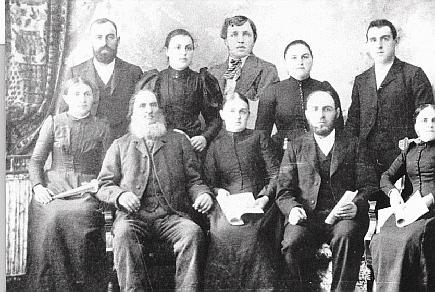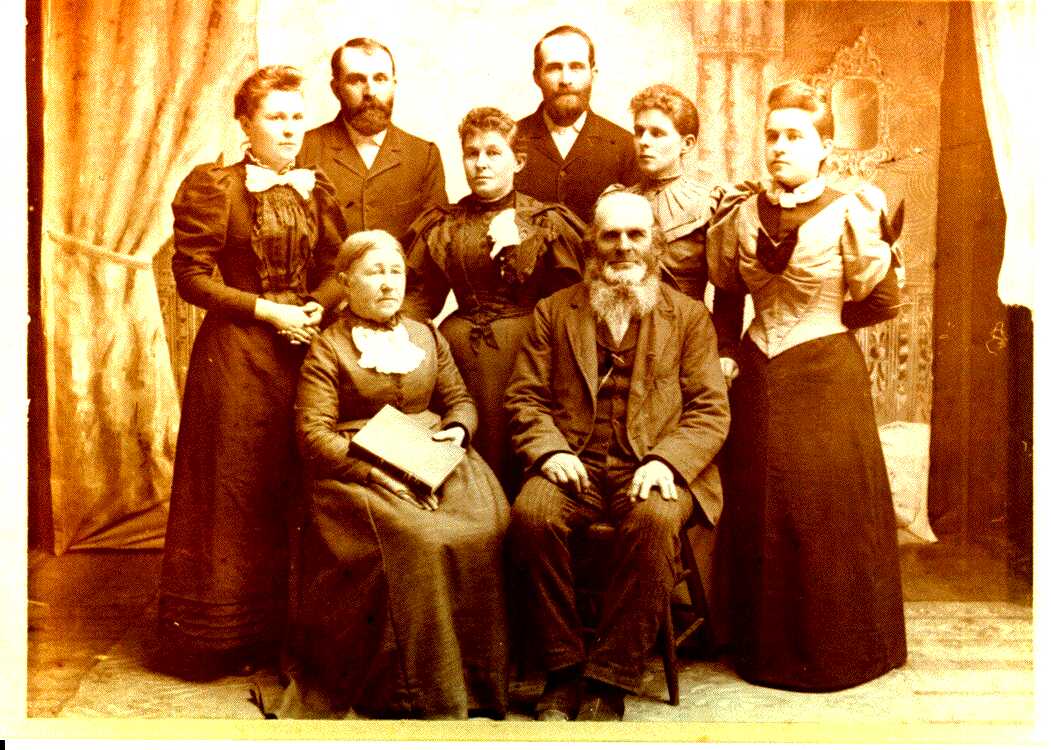Christian and Abraham were brothers, both sons of Abraham.

The Christian Rosenberger
Family
Christian and Abraham were brothers, both sons of Abraham.

The Christian Rosenberger
Family

The Abraham Rosenberger Family,

This image of Maria Rosenberger (Hallman) was recently identified. It has an inscription on the back which reads "For cousin Lovina, with kindest regards, Maria" �Lovina�(fifth from the left in the Abraham Rosenberger family picture) is the daughter of Abraham S. Rosenberger, her full name was Lydia Lovina Rosenberger. She married an Abraham Grove in Michigan and spent the rest of her life in Michigan. Thanks to Leland Rosenberger for this addition.
OF
MONTGOMERY COUNTY, PA
by Rev. A. J. Fretz
The first settler of the name of Rosenberger in Montgomery County was Henry Rosenberger, who came to the Indian Creek valley, in Franconia township, in 1729. In 1739 Benjamin Rosenberger settled in Hatfield township, where in that year he purchased 125 acres of land bordering the County Line at Line Lexington, which he held for five years. Daniel Rosenberger purchased another tract in Hatfield lying along the county Line near the hamlet called Hockertown in 1740.
In the year 1745, Henry Rosenberger, Jr., came in possession by deed of his father's plantation in Franconia township. John Rosenberger settled in Hatfield township and first bought land around where is now that borough of Hatfield about 1749-50.
It is a tradition of the family that the Rosenbergers of Montgomery County, PA., came from Germany, from a place called "Zweibrucken" (two bridges). It is supposed that these families that settled in Franconia and Hatfield townships were all related, and while it is certain that Daniel and John were brothers, it is quite evident that the four above mentioned were all brothers and sons of Henry Rosenberger, Sr.
John Shutt Rosenberger, a great-great-grandson of Benjamin Rosenberger, previous to his death is said to have related that one of his ancestors reached the great age of 96 years. It is not now certain which one of his ancestors he named as having reached that age. He also said that one of his ancestors was born on board sip or soon after the landing in America. It is quite certain that neither Benjamin or his eldest son, Yelles, reached the age of 96 years, therefore it must have been Benjamin's father, the emigrant, who was 96 years old at his death. This would also indicate that Benjamin was the son of a pioneer. It is quite likely that Henry Rosenberger, Sr. The pioneer, lived to be 96 years old, but it is not clear that any of the ancestors were born on the voyage over. Benjamin, who no doubt was the eldest, was in all probability born in Germany, and was a lad of from 11 to 15 years old when he came with his father to America. He was born as early as about 1714 and died about 1777, aged 63 years or more. His eldest son, Yelles, was born before 1735 and died 1808, aged 73 or more. The time of the emigration of Henry Rosenberger, Sr., is not known, but was in all probability between the years of 1720 and 1729. The descendants of Benjamin are now largely settled in Bucks Co., PA, and a considerable number also reside in Waterloo County, Ontario, Canada.
All the earlier members of these families belonged to the religious sect called Mennonite and worshipped at Franconia and Line Lexington meetinghouses.
Since writing the above we have received a communication from Dr. M Elizabeth Rosenberg, of Omaha, Neb., which may throw some light on the early history of the Rosenberger family in Europe. The letter reads as follows:
Omaha, Neb., Sept. 19, 1899
Rev. A. J. Fretz,
Dear Sir:--Forgive me for plunging right into the subject. My time is limited, the story is a long one, the pater's mind is not so strong as it used to be. I have obtained my side of the tree by devious ways.
First, I will tell the story as I think it is; then I will give you proofs as near as I can.
I think we must start with Bohemia in Austria. A family of Rosenberg lived northwest of Vienna on a large estate. History mixes them up with the Hohenzollern family and the religious wars of Austria. Between 1611 and 1660 they were driven out to Switzerland, Holland, England, and lastly they took ship with William Penn. There must have been a father and nine sons. The pater (my father) is the eighth generation from the one coming on the ship.
Proof I. I have heard my father say (when I was small) "my father was of a princely family, There was Von to the name; but he, the original Von Rosenberg, had to drop it because no Von could travel without a permit from his king."
Proof II. A Rosenberg living near Washingtonville, O., sent for my father about the year 1851 to see what their relationship might be, and this cousin said that they (he and my father) were the eighth generation, that the original emigrant was a man with nine sons, that one son went to Virginia and that he was from that branch.
Proof III. My father often heard his father tell that his ancestors were driven out by religious persecution, that they hid in Switzerland in caves, thence fled to Holland and England, that the name was changed during the flight, and the Von never resumed, that a fierce battle was fought before their flight.
Proof IV. There was an article in the "Boston Monthly Scientific" on farming from a traveler in Austria describing the Schwartzenberger estate. These obtained the estate after the flight of the Rosenberg family. Wintergan is the central village. The fish pond still retains its original name, Rosenberg "Teuch." I do not know the date of the article. We and Uncle Dave Rosenberg, of Bettsville, O., have copies of it. The estate consists of 99 villages and 30,000 people, and about 75,000 acres under the control of this Prince.
Very respectfully,
M.E. Rosenberg.
Note: There's no doubt that Henry Rosenberger, Sr. of Franconia, was the present emigrant, and that he in common with other Mennonites fled from Germany on account of religious persecution. Of the earlier history of the family and their connection with the "princely family," the original spelling of the name, as suggested in the foregoing, the number of children the pioneer had, and whether one of the sons emigrated to Virginia or not, we know nothing. We have seen Rosenberger's direct from Austria and Germany and one Rosenberg from Prussia. One of the former from Austria claimed to be of an old Austrian Rosenberger stock, and were Jews. The last mentioned Rosenberg from Prussia, was also a Jew.
A descendant of Henry's, Benjamin Rosenberger, moved to Canada with his family in 1801. The Pennsylvania German pioneers who traveled to Canada to find reasonable farm land are chronicled in the book, "The Trail of the Black Walnut". They knew that where the black walnut trees grew, the soil was rich and their crops would do well.
'The usual mode of travel to the new land
was by 4-horse-drawn covered wagon. These wagons would come to be
called "Conestoga Wagons". Since the wagons were heavily loaded, the
robust persons walked beside the wagons. The cows were shod and
driven after the wagons. The milk that remained from the daily needs
was put into the churn, which was suspended from the wagons. Usually
at the end of the day's journey, the butter was ready for use. The
tar bucket used for lubricating the wagon axle was hung under the
wagon. Frequently, the wagons had to be dismantled, and everything
carried piece by piece across the mire or over the mountains. The
wagon box was sometimes used as a boat to cross the streams. They
required as much as seven weeks to make the journey from Pennsylvania
to Canada. The Allegheny Mountains were the chief barrier. They
endured untold hardships.' From: A Brief History of the
Mennonites in Canada. NOTE: To join our Rootsweb Mail List (free) send an e-mail to: [email protected] In the body of the message type just one word: subscribe
